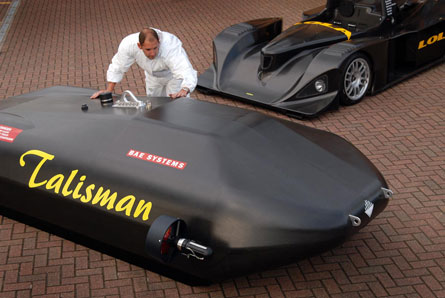BAE Systems says that it has successfully leveraged technologies emerging from its UAV development programmes into the unmanned underwater vehicle (UUV) sector.
The company also says that it is now working on transitioning UAV technology into the unmanned ground vehicle (UGV) sector, including development of cooperative autonomous system operations across air, land and sea environments.
BAE Systems this week has unveiled a new version of its Talisman UUV, while a new company funded UGV development programme is being planned by BAE Systems Australia.
Generic autonomous systems capabilities developed for the UAV segment have resulted in the creation of multiple technology cores that can be applied across different environments says Andy Tonge, Talisman project manager at BAE Systems Underwater Systems
"This is part of an overall strategy across BAE Systems to build up an integrated approach to unmanned vehicles and autonomous systems, leading to the development of Intelligent Autonomy, which can be applied across land, sea and air."

Talisman M alongside a Lola Racing car.
Julia Sutcliffe, unmanned systems research leader with BAE Systems Australia says the approach means “Things like the payloads that were developed for the air platforms are the same electro optic payload that goes on the Talisman. Indeed some of the avionics and the control and the ground segments are common amongst the different autonomous systems”.
The new version of the Talisman UUV, designated Talisman M, is optimised for mine countermeasures operations down to depths of 150m (490ft). The variant follows extensive trials over the past two years with an existing demonstrator vessel built using in-house research and development funding.
Unlike the basic Talisman demonstrator, Talisman M has been extensively streamlined drawing upon expertise from motor racing manufacturer Lola Cars. In turn that firm draws extensively in aerospace sector design, test and evaluation techniques, including the use of wind tunnels.
Tonge says "Talisman M can perform the type of dangerous roles currently performed by service men and women throughout the world - locate, identify and neutralise mines in one single mission without the need for human intervention. Using technology from the non-defence industry has enabled us to develop this UUV more swiftly and cost effectively and to introduce innovative solutions.
The Talisman programme has been underway since 2004 with rapid prototyping allowing fast development and field testing of systems.
Sutcliffe says that the combined knowledge developed in UAV and UUV work is seeing “An expansion of where we are in the air and underwater domains into the land domain.”
BAE Systems Australia last year supported company funded experiments in UAV-UGV cooperation Sutcliffe says, with this effort led by BAE Systems advanced technology centre.
“The UGV platform was the Wildcat platform that has been developed by the advanced technology centre. This group provided the ground control segments and some of the avionics segments and air systems provided the payload and the flight vehicle. That really was the first step in showing the integration of UAVs and UGVs within BAE Systems.
“The next logical step is to do more of that but within BAE Systems Australia it is to acquire a UGV capability. By acquire I mean acquire a vehicle and develop that capability but again it will be an avionics capability, a ground control capability and an autonomous systems technology capability that we already have, just in a new domain."
Source: FlightGlobal.com



















